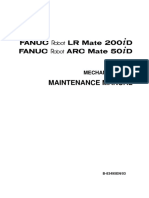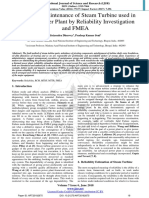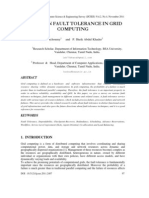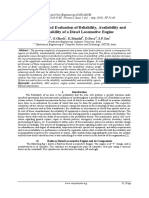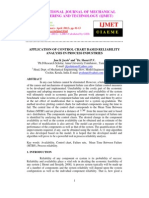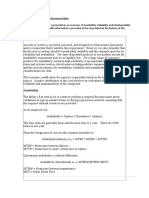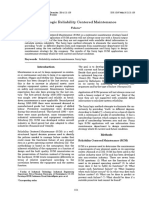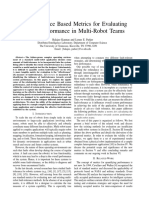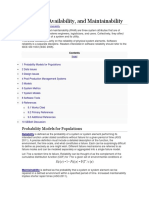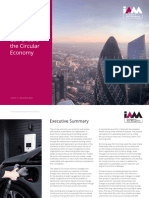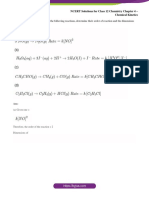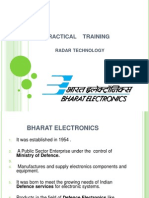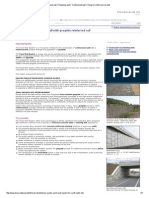Marine Fleet Reliability Availability Maintainability
Marine Fleet Reliability Availability Maintainability
Uploaded by
Carlos Jose Sibaja CardozoCopyright:
Available Formats
Marine Fleet Reliability Availability Maintainability
Marine Fleet Reliability Availability Maintainability
Uploaded by
Carlos Jose Sibaja CardozoCopyright
Available Formats
Share this document
Did you find this document useful?
Is this content inappropriate?
Copyright:
Available Formats
Marine Fleet Reliability Availability Maintainability
Marine Fleet Reliability Availability Maintainability
Uploaded by
Carlos Jose Sibaja CardozoCopyright:
Available Formats
Scientific Journals Zeszyty Naukowe
of the Maritime University of Szczecin Akademii Morskiej w Szczecinie
2022, 70 (142), 63–70
ISSN 1733-8670 (Printed) Received: 27.07.2021
ISSN 2392-0378 (Online) Accepted: 09.01.2022
DOI: 10.17402/509 Published: 30.06.2022
Reliability, availability, and maintainability
analysis of the propulsion system of a fleet
Murat Bayraktar1, Mustafa Nuran2
1
https://orcid.org/0000-0001-7252-4776
2
https://orcid.org/0000-0003-2779-7980
1
Zonguldak Bulent Ecevit University, Maritime Faculty
2
Dokuz Eylül University, Maritime Faculty
Adatepe Neighborhood, Doğuş St., No:207/O, Zip Code:35390, Buca, İzmir, Turkey
e-mail: 1bayraktarmurat@beun.edu.tr, 2mustafa.nuran@deu.edu.tr
corresponding author
Keywords: ship propulsion system, reliability, availability, maintainability, RWB software, RAM analysis
JEL Classification: Q40, D80, R49, C15
Abstract
New systems are produced and developed to meet specific needs, and their reliability is the most important
issue. In the maritime industry, evaluating failures in a ship’s propulsion system results in high costs and the
loss of prestige for the company. Land/sea fleet employees need to detect and minimize the failures that may
occur in ship propulsion systems in advance to ensure the continuity of the ships’ operations. In this study, the
recorded failure data of four different ships belonging to a fleet in the last 10 years are used. Failures were ex-
amined as a whole since the ships have similar propulsion systems. The obtained failure data were grouped, and
the average time to fix the failures was determined by the chief engineer and made suitable for reliability, avail-
ability, and maintainability (RAM) analysis. A suitable model was created for grouped failures by Isograph’s
RWB software. As a result of the analysis of the propulsion system and its subsystems, the main engine of the
ship was shown to have the best reliability. Furthermore, the most important components were the cylinders
of the main engine as subsystems. This study highlights the components that are important to the reliability
of a propulsion system. Thanks to the RAM analysis, improvements can be pinpointed on a ship’s propulsion
system, which will increase the operations of the maritime industry. Reducing failures will further increase the
confidence in maritime transport and strengthen its place among the modes of transportation. This study pro-
vides a valuable resource for academicians, experts, as well as companies working on reliability, availability,
and maintainability in the future.
Introduction without failure. Nowadays, quality targets are real-
ized with RAM analysis to evaluate failures that
The methods and procedures have for quality occur in the item, equipment, or systems during the
assurance and reliability engineering have greatly operation period (Birolini, 2017).
improved in the last 60 years. Reliability, availabil- The reliability of the system is the probability of
ity, and maintainability (RAM) analysis has been performing an operation for a certain period of time
used for complex systems and equipment to mini- and under certain environmental conditions and lim-
mize failures, ensure the continuity of operations, itations (Stapelberg, 2009). Reliability is described
and minimize costs. Until the 1950s, an item met as the probability and failure records obtained during
quality targets when a product left the manufacturer the operation of a system (Di Lorenzo & Rehg,
Zeszyty Naukowe Akademii Morskiej w Szczecinie 70 (142) 63
Murat Bayraktar, Mustafa Nuran
2008). Design guidelines for manufacturing, testing, during the early failure stage, the system operates
and reliability are an essential component for the suc- at a constant failure rate that is called its useful life.
cessful implementation of reliability that describes In this stage, the system operates at the highest reli-
quality over time (Levin & Kalal, 2003). Reliability ability and efficiency. The constant failure rate in the
includes three important parameters: the intended useful life of a system perpetually increases due to
function, a certain time interval, and the specified fatigue, aging, corrosion, electromigration, etc. That
limitations and conditions (Yang, 2007). Reliability stage is called the wear-out stage. Increasing fail-
is measured or estimated by mathematical models or ures create an obstacle to the operation of the sys-
statistical parameters (Lazzaroni, 2011). tem, and thus the system becomes unusable (Laz-
Availability is described as the ratio of delivered zaroni, 2011; Birolini, 2017). While any part of the
to expected service of items (Birolini, 2017). Avail- system is performing its required function, a failure
ability is system reliability based on the maintain- occurs when it stops (Birolini, 2017). The difference
ability of items in a particular system (Stapelberg, between MTBF and MTTF separates their usage
2009). Availability is a situation in which an item can patterns. While MTTF is applied to non-repairable
perform a necessary function under appropriate con- items such as bearings and transistors, MTBF is
ditions of use, assuming maintenance is performed applied to system equipment that can be repaired.
at certain intervals (Lazzaroni, 2011). Evaluating The time between failures excludes the downtime;
the availability of a system is profoundly strenuous hence, MTBF is described as the mean up time
since it is essential to take into account the reliabil- between failures (Smith, 2017). The mean time
ity, maintainability, human aspects, and logistical to failure (MTTF) refers to the average operating
support during calculations. time of the system equipment until the next failure
Maintainability is one aspect of maintenance that occurs (Levin & Kalal, 2003). MTTF and mean time
takes into account the duration of system malfunc- between failures (MTBF) are statistical parameters
tions (Stapelberg, 2009). Maintainability is defined (Lazzaroni, 2011).
as the ability of an equipment or system to perform
its required function under certain conditions when R(t) = e–λt (1)
maintenance of the system is carried out under spe- 1
cific conditions, using the necessary procedures and MTT F Rt dt (2)
0
resources (Lazzaroni, 2011). The bathtub curve is the
most well-known failure rate model, and this curve Assuming the necessary external resources are
is examined in three stages: early failure, useful life, provided, availability is the ability of an element to
and wear out (Figure 1). perform a certain function in a specified time or at
a given moment (Lazzaroni, 2011). The mean time
λ(t) to repair/restore refers to the average repair time of
a malfunction in the system parts (Lazzaroni, 2011).
Early Useful life
failure (constant failure rate)
Wear out The mean time to repair (MTTR) is expressed as
the ratio of the total time spent on repairing the fail-
ures that impede the operation of a system to the
total number of failures (Levin & Kalal, 2003). The
unavailability of a system is expressed as the ratio
of the total time to the downtime (Smith, 2017). To
reduce the unavailability of a system, it is necessary
t
to increase the availability of its subsystems (Pham,
Figure 1. Bathtub Curve (Lazzaroni, 2011) 2006).
A variety of enhancement studies were carried
In the early failure stage, the manufactured part out to adapt to new technological developments at
or installed system is operated for the first time and a global level. RAM applications provide a notable
many failures are observed. (Birolini, 2017) stat- benefit for monitoring and improving the perfor-
ed that the failures occurring at this stage include mance of systems (Mishra & Mishra, 2020). The
weaknesses in materials, components, or production performed RAM analysis aims to reduce the life-cy-
processes. However, the failure of the system, λ(t), cle costs of systems as much as possible (Cai et al.,
decreases quickly over time during the early failure 2018). With the development of technology, oper-
stage (Yang, 2007). After the failures are eliminated ators are expected to minimize the failures in the
64 Scientific Journals of the Maritime University of Szczecin 70 (142)
Reliability, availability, and maintainability analysis of the propulsion system of a fleet
ship’s main and auxiliary engines (Balin, Demirel and VIKOR (Vise Kriterijumska Optimizacija
& Alarçin, 2015). Ship main engine systems con- I Kompromisno Resenje). Firstly, failures observed
tain many components, the most important of which in the main engine arising from the auxiliary systems
is the fuel oil system because many accidents have are expressed. According to the data obtained, five
occurred due to the main engine fuel system failure different failure cases were observed: high heat level
in the last 20 years (Islam et al., 2019). At the begin- in all exhaust cylinders of the engine; unstable engine
ning of the article, a comprehensive literature review speed; shutdown of the engine during normal oper-
was performed for reliability, availability, and main- ation; increase of the oil level during engine opera-
tainability analysis, particularly for marine systems. tion; fire in the scavenging area; surge in the turbo-
A fault tree diagram was created to fully explain all charger. The systems causing these situations were
the details of the RAM analysis on marine vessel examined and divided into four different sub-sys-
propulsion systems, and failure records of fleet ves- tems. The affected ranking was the cooling system,
sels are used to calculate the unavailability and unre- water system, fuel system, governor system, air
liability values in the reliability workbench. supply system, respectively, when using the Fuzzy-
The analysis was performed, and the results sec- VIKOR hybrid method (Balin, Demirel & Alarçin,
tion was created after entering the entire data set. 2015). The software inspection capabilities for
Consequently, evaluation was accomplished accord- enhanced ship safety (INCASS) measures the reli-
ing to the unavailability and unreliability values of ability percentage of ship engine systems by using
the systems and equipment by taking into account an machinery risk assessment (MRA) tools. According
expert’s opinion. to the reliability case study results made on the cylin-
ders, injections, pistons, piping, valve, etc. the most
Literature review reliable components are radial bearings, pistons,
and piping; nevertheless, injections and valves have
In this section, reliability, availability, and main- a low performance reliability (Lazakis et al., 2016).
tainability studies are analyzed in the field of engi- The hybrid method was used with Fuzzy and TOP-
neering, especially ship engine systems. A dynamic SIS to determine most critical failure in the auxiliary
fault tree model was created (Anantharaman et al., systems of a ship’s main engines. According to the
2019) to examine the failures that may interfere with obtained results, the sudden shut down of an engine
the operation of the ship’s main engine systems and during its normal operation is the most critical sit-
components. A fault tree diagram was created for the uation for the main engine system and fuel system,
main engine that includes cooling, lubrication, fuel, taking into account the weights of all decision-mak-
and air systems. Key parameters were determined er groups (Alarçin, Balin & Demirel, 2014).
for physical measurements such as scavenging air A competing risk model was created for reliabil-
temperature and thrust-bearing lube oil outlet pres- ity analysis of two major failures, wear degradation
sure. Moreover, an artificial neural network (ANN) and thermal cracking, occurring in the marine die-
model was constructed for the cylinder exhaust gas sel engine’s cylinder liners. The inputs used in the
temperature. The model results and recorded data model were obtained from the real data, i.e., 33 cyl-
were similar to the recorded and predicted values. inder liners of an 8-cylinder Sulzer RTA 58 engine.
Relevant data were collected to select the best failure Wear degradation and thermal cracking showed
model for use in marine engine systems (Ananthara- a similar progression when comparing the values
man et al., 2019). In this way, a reliability evaluation obtained in the established model and the values
was easily made on the ship engine system compo- obtained from the cylinder liners of diesel engines,
nents. According to the results, a different reliability which are equipped on twin ships of the Grimaldi
model should be created for each component in the Group. (Bocchetti et al., 2009) established a reliabil-
ship propulsion system and a Weibull model should ity structure for two-stroke crosshead diesel engines
be used for estimating the cooling water system. Fur- “MAN B&W 7S50MC-C” and their subsystems by
thermore, the obtained evaluation results are useful using fault tree analysis. In the fault tree block dia-
for planning the maintenance activities on board and gram, main engine failures were examined under five
for minimizing operating malfunctions of a ship’s headings. These are cylinder unit failure, turbo-char-
main engine. ger failure, auxiliary blower I, auxiliary blower II,
Determining the priority order and severity of and common component failures that include crank-
failures that may occur in ship systems is done by shaft failure, cylinder frame, bedplate, chain drive,
combining fuzzy analytic hierarchy process (AHP) scavenge air receiver, exhaust gas receiver, starting
Zeszyty Naukowe Akademii Morskiej w Szczecinie 70 (142) 65
Murat Bayraktar, Mustafa Nuran
air pipe, air cooler, and camshaft failure. According most reliable ones (Islam et al., 2019). To determine
to the obtained results, 47 failure events of indi- the severity of malfunctions in the central cooling
vidual components such as thrust bearings, shafts, system of a bulk carrier, a study was conducted.
and housing failure in systems negatively affect Failure modes and equipment items are expressed in
the operation, and malfunctions occur in the main terms of severity (S), occurrence (O), and likelihood
engine system. Moreover, the 5453 combinations of of non-detection (D) values. These values are used
two-component failures will bring the system into as inputs in the WASPAS method, which species
the down state (Laskowski, 2015). the severity of the failure. An abnormal temperature
The analysis of ship accidents caused by the ship on the lube oil cooler is the most critical one, while
engine suggests the use of the logic programming operating at degraded head/flow performance of the
technique (LPT) method to reveal all the causes of seawater cooling pump is the least important. The
the accident due to ship engine failure. Two actual values obtained with WASPAS are compared with
marine accident cases were taken as references for TOPSIS, and similar ranking results were acquired
the developed method to give full results. A simple (Emovon et al., 2018).
query was generated to understand the accident in all RAM analysis of the seabed storage tank (SST)
details using LPT. As a result, the crew revealed that was performed in four steps: drawing a system
the accidents were thought to be caused by the main boundary, acquiring reliability data, creating a fault
engine failure (Awal & Hasegawa, 2015). Engineer- tree model, and reliability estimation. Five critical
ing failures and optimization were analyzed using events, the most important of which is the external
the hierarchically performed hazard origin & prop- leakage process (ELP), are used as references when
agation studies (HiP-HOPS) method and case stud- calculating the reliability of the SST system. As
ies were performed on the fuel oil service system of a result of the analysis, the reliability of the system
a cargo ship. The optimal design of a fuel oil system was determined to be approximately 98%. (Choi
provided a net benefits increase of 17% (Papadopou- & Chang, 2016) performed a RAM analysis by ref-
los et al., 2011). erencing the data obtained during the packaging
Considering ever-increasing global energy needs production of liquid products. Hence, the mainte-
and environmental degradation, there has been nance intervals of the components in the system are
a movement towards alternative energy sources such clearly determined, and the time and production loss
as renewable energy and LNG that reduce the use of caused by the failures that occurred during the oper-
petroleum-based fuels. Reliability analysis of marine ation in the wine production corporation was dimin-
LNG-diesel dual-fuel engines is performed based on ished (Tsarouhas, 2018). The Markovian approach
the analytic hierarchy process (AHP). According used RAM modeling for a coal-handling system.
to the results obtained, piston ring abnormal wear, (Mishra & Mishra, 2020) also combined this with
adhesive, and breakage are the most critical safety the GO-Bayes method to measure the system safety
elements in terms of failure risk of an LNG-diesel performance on a train air-breaking system (Cai et
dual-fuel engine. Speed, regulation fault, firing, and al., 2018). In this way, improvements were obtained
reversal failure in the control system, fresh seawater compared with existing analysis methods. The new-
pump fault in the cooling system, pressure-limiting ly-developed model provides a noteworthy solution
valve and oil pump fault in the lubrication system, for achieving the results from traditional models
and fuel injector fault in the fuel oil system constitute used in decision-making and risk analysis for mar-
other critical components of marine engine systems. itime systems (Yang & Wang, 2015).
(Wan et al., 2013) performed a reliability analysis
on the fuel oil system through a questionnaire using Methodology
101 expert opinions. The fuel system was divided
into 13 parts: fuel oil suction filter, fuel oil supply In this study, the unreliability and unavailabili-
pump, booster pump, main discharge filter, fuel oil ty values of the propulsion system were calculated
bypass filter, fuel oil heater, viscotherm, fuel injec- based on the failure records of the ships of a fleet.
tion, fuel injector, fuel oil high-pressure pipe, buffer Primarily, failures were obtained that occurred on
tank, service tank, and flowmeter. The fuel oil sys- four ships with similar main engine systems belong-
tem components reliability analysis was performed, ing to the fleet between 2010 and 2019. Failures
and the fuel oil bypass, supply, and suction filters affecting the ship propulsion system were eliminat-
were the most failure-prone components. In contrast, ed from other failures by a marine chief engineer.
the fuel oil service tank and buffer tanks were the Failures affecting the ship propulsion system were
66 Scientific Journals of the Maritime University of Szczecin 70 (142)
Reliability, availability, and maintainability analysis of the propulsion system of a fleet
grouped under the three headings described in Fig- in there will prevent the ship from maneuvering.
ure 2: boiler failures, steering gear failures, and Considering the data set obtained, failures occurring
main engine failures. Fault tree analysis (FTA) was in the main engine were examined under nine head-
used to define and evaluate the relationship between ings: alpha f., fuel system f., cylinder f., control f.,
the failures and the equipment in the system. FTA scavenge f., oil mist f., lubrication oil f., exhaust f.
was performed on the fuel supply pump of the two- and seawater f. (Figure 3).
stroke diesel engine, taking into account the frequent MTTF and MTTR values were calculated using
occurrence of fuel system failures in the ship’s main Excel after the average repair time of the fail-
engines (Golub Medvešek, Šoda & Perić, 2014). ures occurring in components was determined by
Furthermore, FTA and fault diagnosis of the turbo- a marine chief engineer. The analysis was performed
charger system were realized based on the scenarios by the reliability workbench (RWB) product by Iso-
performed on a main engine simulator (Knežević et graph Software that performs fault tree, common
al., 2020). cause, and importance analysis. Also, reliability
block diagram analysis was performed after the fault
Propulsion
tree diagram covering all components was created
System F. of (Isograph, 2021).
Ships in the Fleet
Results and discussion
TP1 Using fleet records, a total of 63 failures affecting
the propulsion system in four ships of the fleet were
determined and seven of these faults were related
to the boiler, eight to the steering gear failures, and
20 to the main engine. The unavailability of the pro-
Boiler F. Main Engine F. Steering Gear F. pulsion system of ships in the fleet is described in
Table 1.
Table 1. Unavailability of the propulsion system of ships in
the fleet
EV1 GT1 EV2
Propulsion System F. of Ships in the Fleet
Unavailability 0.007522
Figure 2. Failures affecting the propulsion system Frequency 0.001553
λ (Lambda) 0.001564
The boiler produces steam that is used as fuel Number expected failures 134
oil heaters, tank heating, etc. It is operated by hot Total down time(hour) 650
exhaust gas, so any fault occurring in this system
makes it impossible for the main engine to run. The According to the analysis, the unavailabili-
steering gear was used to turn the ship, and any fault ty value of the propulsion system of the fleet was
Main
Engine F.
GT1
Alpha F. Fuel Sys. F. Cylinder F. Control F. Scavenge F. Oil Mist F. Lub O. F. Exh. F. Sea W. F.
EV3 EV4 EV5 EV6 EV7 EV8 EV9 EV10 EV11
MTTF=21632.5 MTTF=11860 MTTF=5072.82 MTTF=14420 MTTF=43265 MTTF=21630 MTTF=14414.6 MTTF=21632 MTTF=28844
3529 6667
Figure 3. Failures affecting the main engine
Zeszyty Naukowe Akademii Morskiej w Szczecinie 70 (142) 67
Murat Bayraktar, Mustafa Nuran
0.007522, the frequency was 0.001553, λ (Lamb- 94, 22, and 534 identified in Table 2. Moreover,
da) was 0.001564, and the total down time was 650 the unavailability of the main engine equipment is
hours, as highlighted in Table 1. In addition, the shown in Table 3.
unavailability of equipment affecting the propulsion Reliability analysis results of the main engine
system of ships in the fleet is shown in Table 2. components are shown in Table 3. The cylinder had
0.003535774 unavailability, which was the highest
Table 2. Unavailability of equipment affecting the propul-
sion system of ships in a fleet
value. The other high unavailability values were in
the fuel system and lubrication oil system, 0.000818
Equipment Affecting the Propulsion System of Ships and 0.000647, respectively. Alpha, exhaust, scav-
in the Fleet enge and seawater systems constituted the most
Boiler F.
Steering Main available equipment in the main engine system.
Gear F. Engine F. Considering 86,544 working hours of 4 ships
Unavailability 0.001086 0.000254206 0.006191 in the fleet, the best in terms of reliability were the
Frequency 8.088E-05 6.93289E-05 0.001405 steering gear and boiler highlighted in Figure 4. The
λ (Lambda) 8.097E-05 6.93465E-05 0.001414 main engine comes after the others in terms of reli-
Number of Expected F. 7 6 121 ability since the majority of failures were caused by
Total down time 94 22 534 the main engine system.
The reliability analysis of the main engine equip-
Evaluating the outputs from Table 2, the main ment shows that the scavenger is the most reliable
engine has the highest unavailability ranking, whose one, as shown in Figure 5. In the reliability curve,
value is 0.009161. This unavailability value is the exhaust, lubrication oil, fuel system, and cylinder
approximately 6 times larger than that of the boil- followed the scavenger, respectively.
er and about 2.5 times larger than that of the steer- Similarly, to ensure maximum reliability in
ing gear. In the sense of total down time hours were a two-stroke marine diesel engine, all components
Table 3. Unavailability of the main engine equipment
Main engine equipment’s Unavailability Frequency λ (Lambda) Number of failures Total down time (h)
Alpha F. 0.00016 0.04622 0.04623 4 14
Fuel Sys F. 0.00082 8.42E-05 8.43E-05 7 68
Cylinder F. 0.00354 0.000196 0.000197 17 306
Control F. 0.00028 6.93289 6.93481 6 24
Scavenge F. 0.00016 2.31E-05 2.31E-05 2 14
Oil Mist F. 0.00028 4.62193 4.62321 4 24
Lub O. F. 0.00065 0.000069 0.000069 6 56
Exh. F. 0.00019 0.000046 0.000046 4 16
Sea W. F. 0.00014 0.000035 0.000035 3 12
1 Boiler F.
0.9 Main Engine F.
0.8
Steering Gear F.
0.7
0.6
Unreliability
0.5
0.4
0.3
0.2
0.1
0
0 8654.4 17309 25963 34618 43272 51926 60581 69235 77890 86544
Time
Figure 4. Unreliability of equipment affecting the propulsion system of ships in the fleet
68 Scientific Journals of the Maritime University of Szczecin 70 (142)
Reliability, availability, and maintainability analysis of the propulsion system of a fleet
1 Alpha F.
Control F.
0.9
Cylinder F.
0.8 Exh. F.
0.7
Fuel Sys. F.
Lub O. F.
0.6
Unreliability
Oil Mist F.
0.5 Scavenge F.
Sea W. F.
0.4
0.3
0.2
0.1
0
0 8654.4 17309 25963 34618 43272 51926 60581 69235 77890 86544
Time
Figure 5. Unreliability of the main engine’s equipment
that may cause a fuel pump failure are specified, so primarily in the sealing elements, if a failure
that the failures can be easily eliminated in case of occurred. These failures were minimized with regu-
any malfunction (Golub Medvešek, Šoda & Perić, lar maintenance on the sealing elements.
2014). Air filter fouling, a high fouling level of the Thanks to RAM analysis, system and sub-system
turbine wheel, and air cooler faults affect turbo- components whose reliability should be increased in
charger performance, which affects fuel consump- the propulsion system were expressed. In this way,
tion, emission rate, maintenance costs, etc. These with the improvements to be made on failures, the
negative situations are minimized thanks to the confidence in the fleet increased, so it will be pre-
fault diagnosis and FTA when they are performed ferred more. The results obtained from the analysis
early enough (Knežević et al., 2020). FTA was per- can be strengthened by acquiring new data from
formed on the main engine, transmission equipment, ships belonging to the fleet. These results will frame
marine shafting, and propeller failures to evaluate a worthwhile initiative for academicians, experts,
the marine propulsion system reliability, which can and companies studying reliability, availability, and
change depending on the weather conditions and maintainability in the future.
operation areas (Ta et al., 2017).
References
Conclusions
1. Alarçin, F., Balin, A. & Demirel, H. (2014) Fuzzy
In this paper, RAM analysis was performed on AHP and Fuzzy TOPSIS integrated hybrid method for
auxiliary systems of ship main engines. Journal of Ma-
the propulsion system of four ships belonging to
rine Engineering & Technology 13(1), pp. 3–11, doi:
a fleet. According to the results obtained, the main 10.1080/20464177.2014.11020288.
engine had the lowest rating in terms of availabil- 2. Anantharaman, M., Islam, R., Khan, F., Garaniya, V.
ity. In terms of sub-systems, the cylinder had the & Lewarn, B. (2019) Data analysis to evaluate reliabil-
highest unavailability value. The cylinder operat- ity of a main engine. TransNav 13(2), pp. 403–407, doi:
10.12716/1001.13.02.18.
ing areas have high temperatures, working of met- 3. Awal, Z.I. & Hasegawa, K. (2015) Analysis of Ship Ac-
al-metal surfaces, high power generation, different cidents due to Marine Engine Failure-Application of Logic
fuel types, and different combustion quality, which Programming Technique (LPT). Marine Engineering 50(6),
all negatively affect the availability of the compo- pp. 744–751, doi: 10.5988/jime.50.744.
4. Balin, A., Demirel, H. & Alarçin, F. (2015) A hierarchi-
nents. Therefore, regular periodic maintenance must
cal structure for ship diesel engine trouble-shooting problem
be performed on the cylinder. using fuzzy AHP and fuzzy VIKOR hybrid methods. Brodo-
The reason for the relatively low availability of gradnja 66(1), pp. 54–65.
the fuel system and lubrication oil system is pollu- 5. Birolini, A. (2017) Reliability engineering. Berlin, Germa-
tion in the piping system and blockages caused by ny: Springer.
6. Bocchetti, D., Giorgio, M., Guida, M. & Pulcini, G.
the poor quality of the fuel/oil used. Steering gear (2009) A competing risk model for the reliability of cylinder
had the highest availability since they use hydrau- liners in marine Diesel engines. Reliability Engineering &
lic systems. Moreover, deformation was observed System Safety 94(8), pp. 1299–1307.
Zeszyty Naukowe Akademii Morskiej w Szczecinie 70 (142) 69
Murat Bayraktar, Mustafa Nuran
7. Cai, G., Wang, Y., Song, Q. & Yang, C. (2018) RAMS 18. Levin, M.A. & Kalal, T.T. (2003) Improving product reli-
Analysis of Train Air Braking System Based on GO-Bayes ability: strategies and implementation (Vol. 1). John Wiley
Method and Big Data Platform. Complexity 2018(2), & Sons.
pp. 1–14, doi: 10.1155/2018/5851491. 19. Mellal, M.A. & Williams, E.J. (2018) Large-scale reli-
8. Choi, I.-H. & Chang, D. (2016) Reliability and avail- ability-redundancy allocation optimization problem using
ability assessment of seabed storage tanks using fault tree three soft computing methods. In: Modeling and simulation
analysis. Ocean Engineering 120, pp. 1–14, doi: 10.1016/ based analysis in reliability engineering. CRC Press Taylor
j.oceaneng.2016.04.021. & Francis Group.
9. Di Lorenzo, R.A. & Rehg, V. (2008) Reliability, Maintain- 20. Mishra, A. & Mishra, R.P. (2020) RAM modeling for
ability, and Availability for Engineers. Kettering, Ohio. performance analysis of a coal handling system. Materials
10. Emovon, I., Norman, R.A., Murphy, A.J. & Okwu, M.O. Today: Proceedings 28, 4, pp. 2149–2155, doi: 10.1016/
(2018) Application of WASPAS in enhancing reliability cen- j.matpr.2020.04.140.
tred maintenance for ship system maintenance. Journal of 21. Papadopoulos, Y., Walker, M., Parker, D., Rüde, E.,
Engineering and Technology 9(1), pp. 35–53 Hamann, R., Uhlig, A., Grätz, U. & Lien, R. (2011) Engi-
11. Golub Medvešek, I., Šoda, J. & Perić, T. (2014) Fault neering failure analysis and design optimisation with HiP-
Tree Analysis in the Reliability of Heavy Fuel Oil Sup- HOPS. Engineering Failure Analysis 18(2), pp. 590–608,
ply. Transactions on Maritime Science 3(2), pp. 131–136, doi: 10.1016/j.engfailanal.2010.09.025.
doi: 10.7225/toms.v03.n02.004. 22. Pham, H. (Ed.) (2006) Springer handbook of engineering
12. Islam, R., Anantharaman, M., Khan, F. & Garaniya, V. statistics. Springer Science & Business Media.
(2019) Reliability assessment of a main propulsion engine 23. Smith, D.J. (2017) Reliability, maintainability and risk:
fuel oil system-what are the failure-prone components? practical methods for engineers. Butterworth-Heinemann.
TransNav 13(2), pp. 415–420, doi: 10.12716/1001.13.02.20. 24. Stapelberg, R.F. (2009) Handbook of reliability, availabili-
13. Isograph (2021) Reliability Workbench. [Online] Available ty, maintainability and safety in engineering design. Spring-
from: https://www.isograph.com/software/reliability work- er Science & Business Media.
bench/ [Accessed: March 08, 2021]. 25. Ta, T.V., Thien, D.M. & Cang, V.T. (2017) Marine Pro-
14. Knežević, V., Orović, J., Stazić, L. & Čulin, J. (2020) pulsion System Reliability Assesment by Fault Tree Anal-
Fault tree analysis and failure diagnosis of marine diesel en- ysis. International Journal of Mechanical Engineering
gine turbocharger system. Journal of Marine Science and and Applications. Special Issue: Transportation Engineer-
Engineering 8(12), 1004, doi: 10.3390/imse8121004. ing Technology – Part III 5(4–1), pp. 1–7, doi: 10.11648/
15. Laskowski, R. (2015) Fault Tree Analysis as a tool for j.ijmea.s.2017050401.11.
modelling the marine main engine reliability structure. 26. Tsarouhas, P. (2018) Reliability, availability and maintain-
Scientific Journals of the Maritime University of Szczecin, ability (RAM) analysis for wine packaging production line.
Zeszyty Naukowe Akademii Morskiej w Szczecinie 41(113), International Journal of Quality & Reliability Management
pp. 71–77. 35(3), pp. 821–842, doi: 10.1108/IJQRM-02-2017-0026.
16. Lazakis, I., Dikis, K., Michala, A.L. & Theotokatos, G. 27. Wan, C., Yan, X.P., Zhang, D. & Fu, S. (2013) Reliability
(2016) Advanced ship systems condition monitoring for analysis of a marine LNG-diesel dual fuel engine. Chemical
enhanced inspection, maintenance and decision making Engineering Transactions 33, pp. 811–816, doi: 10.3303/
in ship operations. Transportation Research Procedia 14, CET1333136.
pp. 1679–1688, doi: 10.1016/j.trpro.2016.05.133. 28. Yang, G. (2007) Life cycle reliability engineering. John Wi-
17. Lazzaroni, M. (2011) Reliability engineering: basic con- ley & Sons.
cepts and applications in ICT. Springer Science & Business 29. Yang, Z. & Wang, J. (2015) Use of fuzzy risk assessment in
Media. FMEA of offshore engineering systems. Ocean Engineering
95, pp. 195–204, doi: 10.1016/j.oceaneng.2014.11.037.
Cite as: Bayraktar, M., Nuran, M. (2022) Reliability, availability, and maintainability analysis of the propul-
sion system of a fleet. Scientific Journals of the Maritime University of Szczecin, Zeszyty Naukowe Akademii
Morskiej w Szczecinie 70 (142), 63–70.
70 Scientific Journals of the Maritime University of Szczecin 70 (142)
You might also like
- Rta 84 CDocument209 pagesRta 84 CNguyễn Linh100% (1)
- LRMate200iD Maintenance Manual (B-83495EN 03)Document160 pagesLRMate200iD Maintenance Manual (B-83495EN 03)mbz100% (1)
- 4emss2014 2Document5 pages4emss2014 2Victor AlvarezNo ratings yet
- 10 1108 - Ijqrm 02 2014 0016Document21 pages10 1108 - Ijqrm 02 2014 0016DaveNo ratings yet
- Criticality Analysis of Process SystemsDocument8 pagesCriticality Analysis of Process SystemschevroletNo ratings yet
- Preventive Maintenance of Steam Turbine Used in Thermal Power Plant by Reliability Investigation and FMEADocument5 pagesPreventive Maintenance of Steam Turbine Used in Thermal Power Plant by Reliability Investigation and FMEAsaratchandranb100% (1)
- An Obsolescence Management FrameworkDocument20 pagesAn Obsolescence Management FrameworkJhoan Smith Chaves PeñaNo ratings yet
- IFTCSDocument20 pagesIFTCShamza shahbazNo ratings yet
- Modal Acoustic Emission For Composite Structures Health Monitoring Issues To Save Computing Time and Algorithmic Implementation 2018Document9 pagesModal Acoustic Emission For Composite Structures Health Monitoring Issues To Save Computing Time and Algorithmic Implementation 2018Hridya LalNo ratings yet
- Tema de Casa WordDocument12 pagesTema de Casa WordAndrei RusuNo ratings yet
- 1 s2.0 S0951832020307328 MainDocument13 pages1 s2.0 S0951832020307328 MaingeeforeNo ratings yet
- Chapter IDocument7 pagesChapter IShaku SinglaNo ratings yet
- 2 Level of Repair Analysis Based On Genetic Algorithm With Tabu Search, 2010Document8 pages2 Level of Repair Analysis Based On Genetic Algorithm With Tabu Search, 2010Clovis NetoNo ratings yet
- Survey ON Fault Tolerance IN Grid Computing: P. Latchoumy and P. Sheik Abdul KhaderDocument14 pagesSurvey ON Fault Tolerance IN Grid Computing: P. Latchoumy and P. Sheik Abdul KhaderijcsesNo ratings yet
- An Overview On Reliability, Availability, Maintainability and Supportability (RAMS) EngineeringDocument15 pagesAn Overview On Reliability, Availability, Maintainability and Supportability (RAMS) EngineeringKrinta AlisaNo ratings yet
- A Stochastic Model For Achieving Required Level of Availability Based On The Repair Rate AnalysisDocument5 pagesA Stochastic Model For Achieving Required Level of Availability Based On The Repair Rate AnalysisСтефан ПанићNo ratings yet
- 1 Level of Repair Analysis Including Failure Analysi 2021Document31 pages1 Level of Repair Analysis Including Failure Analysi 2021Clovis NetoNo ratings yet
- 10.1016 J.psep.2022.05.016 j9nsDocument12 pages10.1016 J.psep.2022.05.016 j9nsrgh19No ratings yet
- 1 s2.0 S1474667017415345 Main - 2Document6 pages1 s2.0 S1474667017415345 Main - 2CARLOS JESÚS GRADOS LEÓNNo ratings yet
- 2021 - GPR - Prognostic Techniques For Aeroengine Health Assessment RUL Estimation - ItalyDocument17 pages2021 - GPR - Prognostic Techniques For Aeroengine Health Assessment RUL Estimation - ItalyRachit SinghNo ratings yet
- E23b PDFDocument16 pagesE23b PDFAswad Che RusminNo ratings yet
- 2 Optimizing The Performance of Complex Maintenance Sustems 2013Document7 pages2 Optimizing The Performance of Complex Maintenance Sustems 2013Clovis NetoNo ratings yet
- 2015 Kurian Component-Reliability-Assessment-of-Offshore-Jacket-PlatformsDocument11 pages2015 Kurian Component-Reliability-Assessment-of-Offshore-Jacket-Platformsklop disposableNo ratings yet
- Ijmet: International Journal of Mechanical Engineering and Technology (Ijmet)Document13 pagesIjmet: International Journal of Mechanical Engineering and Technology (Ijmet)IAEME PublicationNo ratings yet
- Availibility TestDocument16 pagesAvailibility Testrudy_423522658No ratings yet
- Maintenance Strategy Optimization in Mineral Processing Multi Component Systems A Case Study of Slurry Filtration Plant IJERTV13IS010043Document5 pagesMaintenance Strategy Optimization in Mineral Processing Multi Component Systems A Case Study of Slurry Filtration Plant IJERTV13IS010043Thakur YogendraNo ratings yet
- Grunske Et Al-2011-Software Practice and ExperienceDocument26 pagesGrunske Et Al-2011-Software Practice and ExperienceBruno LeãoNo ratings yet
- Standardizing Availability Definition: Vamshi K. KatukooriDocument22 pagesStandardizing Availability Definition: Vamshi K. Katukooripartho143No ratings yet
- 2-Jia2015 2Document10 pages2-Jia2015 2Mamad VigilanteNo ratings yet
- Availability, Reliability, MaintainabilityDocument3 pagesAvailability, Reliability, MaintainabilityTyler GoodwinNo ratings yet
- FELECIA - Fuzzy Logic Reliability Centered MaintenanceDocument7 pagesFELECIA - Fuzzy Logic Reliability Centered MaintenanceJoseph Anthony Ramos ArellanoNo ratings yet
- Fault Tolerance MetricsDocument8 pagesFault Tolerance MetricsctorreshhNo ratings yet
- Annual Reviews in Control: Marco Muenchhof, Mark Beck, Rolf IsermannDocument13 pagesAnnual Reviews in Control: Marco Muenchhof, Mark Beck, Rolf IsermannMarwan MayyarNo ratings yet
- Reliability Analysis in The Formulating of Maintenance Program - IOSR - O. E. Isaac PDFDocument8 pagesReliability Analysis in The Formulating of Maintenance Program - IOSR - O. E. Isaac PDFKaique Cavalcante100% (1)
- Remaining Useful Life Estimation: ReviewDocument14 pagesRemaining Useful Life Estimation: ReviewSaeed RahimpourNo ratings yet
- Electronics 04 00526Document12 pagesElectronics 04 00526mathew holeyNo ratings yet
- Ocean Engineering: Demetrious T. Kutzke, James B. Carter, Benjamin T. HartmanDocument15 pagesOcean Engineering: Demetrious T. Kutzke, James B. Carter, Benjamin T. Hartmanyanbiao liNo ratings yet
- A_prediction_tool_for_maintenance_costs_estimationDocument12 pagesA_prediction_tool_for_maintenance_costs_estimationildefonso machucaNo ratings yet
- Reliability Theory: Dr. Shakuntla Singla Associate Professor Department of Mathematics and HumanitiesDocument29 pagesReliability Theory: Dr. Shakuntla Singla Associate Professor Department of Mathematics and HumanitiesShaku SinglaNo ratings yet
- Control Engineering Practice: Ting Yang, Yili Fu, Mahdi TavakoliDocument11 pagesControl Engineering Practice: Ting Yang, Yili Fu, Mahdi Tavakolijose luis huayanay villarNo ratings yet
- Residual Life Assessment IJERTV4IS031113Document8 pagesResidual Life Assessment IJERTV4IS031113raymondNo ratings yet
- 96 IMechE RelAss TRMJDADocument14 pages96 IMechE RelAss TRMJDAJoann HowardNo ratings yet
- Predictive Maintenance of Maritime Systems: Models and ChallengesDocument10 pagesPredictive Maintenance of Maritime Systems: Models and ChallengesSullivan F'gNo ratings yet
- CompareDocument14 pagesComparefredyNo ratings yet
- System Performance Prognostic: Context, Issues and RequirementsDocument7 pagesSystem Performance Prognostic: Context, Issues and Requirementsmy_scribd_2010No ratings yet
- Modelling Worker Fatigue and Recovery in Dual-Resource Constrained SystemsDocument10 pagesModelling Worker Fatigue and Recovery in Dual-Resource Constrained SystemsRodrigo Araya HerreraNo ratings yet
- Reliability, Availability, and Maintainability: Probability Models For PopulationsDocument8 pagesReliability, Availability, and Maintainability: Probability Models For PopulationsMani KumarNo ratings yet
- Resilience Management Problem in ATM Systems AsDocument8 pagesResilience Management Problem in ATM Systems AsraaralmeidaNo ratings yet
- The Role of N H P P Models in The Practical Analysis of Maintenance Failure DataDocument8 pagesThe Role of N H P P Models in The Practical Analysis of Maintenance Failure DataRoberto Cepeda CastelloNo ratings yet
- 1 s2.0 S0003687021003173 MainDocument8 pages1 s2.0 S0003687021003173 Mainlevini6791No ratings yet
- State-of-the-Art Predictive Maintenance TechniquesDocument13 pagesState-of-the-Art Predictive Maintenance TechniquesKleber VieiraNo ratings yet
- Integrated Topology and Controller Optimization of Motion Systems in The Frequency DomainDocument13 pagesIntegrated Topology and Controller Optimization of Motion Systems in The Frequency DomainSlijpselNo ratings yet
- Modal AnalysisDocument10 pagesModal Analysislrodriguez_892566No ratings yet
- Performance Analysis of A Selected System in A Process IndustryDocument5 pagesPerformance Analysis of A Selected System in A Process IndustrySanjay Kajal100% (1)
- A Comprehensive Approach in Performance Evaluation For Modern Real-Time Operating SystemsDocument8 pagesA Comprehensive Approach in Performance Evaluation For Modern Real-Time Operating Systemsjustinleelee0273No ratings yet
- Relationship Between Availability and ReliabilityDocument20 pagesRelationship Between Availability and ReliabilitySudev NairNo ratings yet
- C-Mechanical Systems and Signal Processing - Compressed-MinDocument22 pagesC-Mechanical Systems and Signal Processing - Compressed-Minz mousaviNo ratings yet
- 5 - A Transmissibility-Based Procedure To Estimate The Modal Properties of An On-Board Tuned Mass Damper (2020)Document12 pages5 - A Transmissibility-Based Procedure To Estimate The Modal Properties of An On-Board Tuned Mass Damper (2020)FabianaDaRosaSufiattiNo ratings yet
- LECTURA 3 - Reliability Aspects of TribologyDocument8 pagesLECTURA 3 - Reliability Aspects of Tribologyeduardoperez.uniNo ratings yet
- Engineering a Safer World: Systems Thinking Applied to SafetyFrom EverandEngineering a Safer World: Systems Thinking Applied to SafetyRating: 4 out of 5 stars4/5 (4)
- 10 Components of Lubrication ReliabilityDocument103 pages10 Components of Lubrication ReliabilityCarlos Jose Sibaja CardozoNo ratings yet
- Materials and Qualification Procedures For Ships Book P November 2023Document62 pagesMaterials and Qualification Procedures For Ships Book P November 2023Carlos Jose Sibaja CardozoNo ratings yet
- Spare Part Criticality IndexDocument3 pagesSpare Part Criticality IndexCarlos Jose Sibaja CardozoNo ratings yet
- Astm E563Document4 pagesAstm E563Carlos Jose Sibaja CardozoNo ratings yet
- Iso 17485 2006Document13 pagesIso 17485 2006Carlos Jose Sibaja CardozoNo ratings yet
- IAM, How Asset Management Can Enable The Circular EconomyDocument18 pagesIAM, How Asset Management Can Enable The Circular EconomyCarlos Jose Sibaja CardozoNo ratings yet
- Reliability - Introduction To MTBF and CalculationsDocument15 pagesReliability - Introduction To MTBF and CalculationsCarlos Jose Sibaja CardozoNo ratings yet
- HumedadDocument49 pagesHumedadCarlos Jose Sibaja CardozoNo ratings yet
- Value Stream VSM TemplateDocument6 pagesValue Stream VSM TemplateCarlos Jose Sibaja CardozoNo ratings yet
- Datos Oreda Modos de Falla Parte MantenibleDocument135 pagesDatos Oreda Modos de Falla Parte MantenibleCarlos Jose Sibaja Cardozo100% (2)
- Incident Report of Pneumatic Test FatalityDocument3 pagesIncident Report of Pneumatic Test FatalityCarlos Jose Sibaja CardozoNo ratings yet
- Manual Microsoft ProjectDocument368 pagesManual Microsoft ProjectCarlos Jose Sibaja CardozoNo ratings yet
- Plantilla R&R Variables-ANOVA Julio2013Document4 pagesPlantilla R&R Variables-ANOVA Julio2013Carlos Jose Sibaja CardozoNo ratings yet
- Terralin 2 L FL: Safety Data SheetDocument6 pagesTerralin 2 L FL: Safety Data SheetMelissa ThompsonNo ratings yet
- Midterm Exam TipDocument2 pagesMidterm Exam Tipmedlync100% (1)
- CIVE 311 Lecture On Geosynthetics - Civil Engineering MaterialsDocument41 pagesCIVE 311 Lecture On Geosynthetics - Civil Engineering MaterialsBoago Motswà GoleNo ratings yet
- SyllabusDocument178 pagesSyllabusPonnaiahKannanNo ratings yet
- Steady State DisturbancesDocument3 pagesSteady State DisturbancesHabibi MaghribiNo ratings yet
- WIWXKDocument2 pagesWIWXKGuillermo BelliNo ratings yet
- Worm Gears NBHDocument24 pagesWorm Gears NBHlemebad103No ratings yet
- Grasshopper v2 0 2 UserGuideDocument134 pagesGrasshopper v2 0 2 UserGuideCharles Franklin JosephNo ratings yet
- Act 4065Document9 pagesAct 4065bob75No ratings yet
- Alternator AK6450Document8 pagesAlternator AK6450Cris_eu09No ratings yet
- NCERT Solutions For Class 12 Chemistry Chapter 4 Chemical KineticsDocument42 pagesNCERT Solutions For Class 12 Chemistry Chapter 4 Chemical KineticsAbhishek KumarNo ratings yet
- Peter DruckerDocument19 pagesPeter DruckerAjnie Saidali DimasangkayNo ratings yet
- Rac Lab Experiment:-1: Aim TheoryDocument36 pagesRac Lab Experiment:-1: Aim TheorySatvinder SinghNo ratings yet
- Air Dome Floor Layout20190625Document3 pagesAir Dome Floor Layout20190625chanthulNo ratings yet
- MCQ400Document72 pagesMCQ400PrajithEvNo ratings yet
- Section6 Stimulation EquipmentDocument18 pagesSection6 Stimulation EquipmentAnonymous uKoNmLxk100% (2)
- Hondametc Civic 2004Document88 pagesHondametc Civic 2004hari yadiNo ratings yet
- KEAM 2014 Last Rank Phase 2Document23 pagesKEAM 2014 Last Rank Phase 2Lohith_EnggNo ratings yet
- Optical Fiber Network: TistaDocument1 pageOptical Fiber Network: Tistaatik1603034No ratings yet
- Enzyme Kinetics ExptsDocument13 pagesEnzyme Kinetics ExptsChemistryIndianguyNo ratings yet
- Conditional Formatting in A Visual FoxPro GridDocument5 pagesConditional Formatting in A Visual FoxPro GridtamadjayaNo ratings yet
- Aluminium Brochure PDFDocument24 pagesAluminium Brochure PDFHassan Hassan100% (1)
- Excess and Saving StatementDocument3 pagesExcess and Saving StatementVivek kudaleNo ratings yet
- Practical Training: Radar TechnologyDocument15 pagesPractical Training: Radar TechnologyIshita GroverNo ratings yet
- Design and Uses of Prestressed Concrete Columns: by Raymond ItayaDocument8 pagesDesign and Uses of Prestressed Concrete Columns: by Raymond ItayaVegetable BunNo ratings yet
- Panel Wall - Retaining Wall - Confinement Wall - Geogrid Reinforced Soil WallDocument4 pagesPanel Wall - Retaining Wall - Confinement Wall - Geogrid Reinforced Soil WalljeanfatNo ratings yet
- CDP Bhedaghat EnglishDocument202 pagesCDP Bhedaghat EnglishCity Development Plan Madhya Pradesh100% (4)
- PQT Chapter 9a Phase DiagramsDocument53 pagesPQT Chapter 9a Phase DiagramsDương Hữu PhươngNo ratings yet

